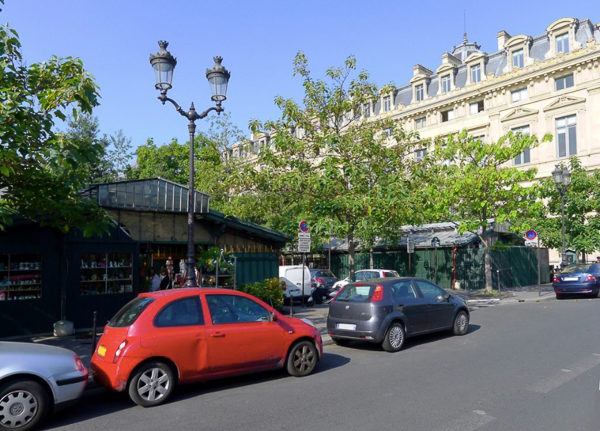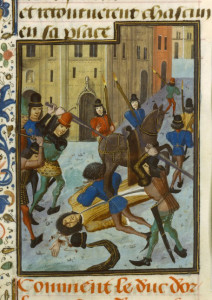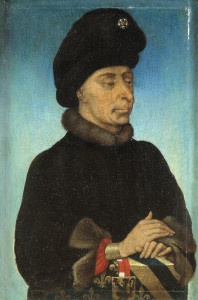Flowers and Birds

In the middle of an island (Île de la Cité) in the middle of the Seine River (France) and in the heart of Paris sits a flower market. It is called the Marché aux Fleurs and you can visit it every day of the week. That is, except on Sunday when it is transformed into the Marché aux Oiseaux (bird market). The market has been in operation since 1808—more than 200 years ago—a very short amount of time when putting it into perspective with the history of Paris.
A Jewish Community
Almost a thousand years ago, this small plot of land was home to the Jewish population of Paris. It was considered one of the first Jewish quarters (or ghettos) in Paris. Today we think of the Marais District as the heart of the contemporary Parisian Jewish community with streets such as Rue Pavée, Rue des Rosiers, Rue des Ecouffes (often used as a derisive word for pawnbroker), and Rue Ferdinand Duval (a.k.a. Rue des Juifs—Street of the Jews—until 1900).

The twelfth century Jewish community on the Île de la Cité was bounded by Rue de la Cité (then known as Rue des Juifs: different street than the one in the Marais), the Quai de la Corse, and Rue de Lutèce. A 12th-century synagogue stood on this site. Small Jewish communities began here during the 10th- and 11th-centuries. Eventually, several communities settled on the Left Bank. One was located on Rue de la Harpe, bounded by Rue de la Huchette and Rue Saint-Séverin. Another Jewish community was located on Rue de la Vielle Juiverie (Old Jewry Street—no longer in existence). Two Jewish cemeteries were once located at the corner of Boulevard Saint-Michel and Rue Monsieur-le-Prince as well as the corner of Rue Pierre-Sarazin and Boulevard Saint-Michel. Each met the same fate as all municipal cemeteries—shut down with their occupants ending up in the Paris Catacombs.
Today, this area on the island is known as the Place Louis-Lépine. This small square is named for Louis Lépine, a 19th- and 20th-century prefect de police (chief of police).
Louis Lépine
Louis Lépine (1846–1933) was known as “The Little Man with the Big Stick.” He served Paris as the head of the police from 1893 to 1913, with two years off between 1897 and 1899. Lépine is given credit for modernizing the Paris police force, including the introduction of forensic science and fingerprinting. Before Lépine, the Paris police force was known for its corruption and low standards. Lépine turned the department around and created a well-respected, professional, and modern police force. Appropriately, the Préfecture de Police (police headquarters) is located across the street from the Place Louis-Lépine.
Guillaume de Tignonville

One of Lépine’s medieval predecessors was Guillaume de Tignonville (c. 1347–1414). Beginning in 1401, de Tignonville was appointed to be the provost of Paris (essentially, the police chief and the king’s top law enforcement officer). On the evening of 23 November 1407, the king’s younger brother, Louis, Duke of Orléans, was murdered. Guillaume was given the responsibility for finding and bringing the murderer to justice. Louis was ambushed in the narrow street Rue Vieille du Temple. His murderers hacked him to death and then fled. At the scene of the crime de Tignonville discovered that what was left of the body had been carried to a house (where 42-43, rue Vieille du Temple now stands). He examined the body and reported one hand had been cut off, an arm slashed to the bone, and the head mutilated to the point that the brain spilled out. The provost ordered all the city gates closed, sent men out to search the general area of the ambush site, and then set about solving the crime. What he found out shocked everyone.
Spoiler Alert

The murderer was the king’s cousin, John the Fearless who confessed to the crime. It would mark the beginning of a French civil war between the Armagnacs (supporters of the monarchy) and the Burgundians (those who supported John, Duke of Burgundy). You will follow the story of Louis and John in our new books Where Did They Burn the Last Grand Master of the Knights Templar? A Walking Tour of Medieval Paris (Volumes One and Two).
Someone Is Reading Our Blogs
I’d like to thank Mark V. for his kind comments concerning our first series of walking tour books, Where Did They Put the Guillotine? Mark visited Paris taking one of the walking tour books. He followed the exact route Marie Antoinette took to the guillotine. I appreciated his comments and suggestions.
What’s New With Sandy and Stew?
The final galley of Where Did They Burn the Last Grand Master of the Knights Templar? A Walking Tour of Medieval Paris is about to be submitted to our printer (Pollock Printing). We will then begin to put together the electronic version. At this time, Volume Two will be published only as an electronic version.
Sandy and Stew will be visiting Paris in September 2016 to wrap up our research for the next book, Where Did They Put the Gestapo Headquarters? A Walking Tour of Nazi Occupied Paris (1940–1944). We’re looking forward to seeing our friend, Raphaelle Crevet. She is a talented private guide and I highly recommend her if you are visiting Paris and some of the attractions outside the city (raphaellecrevet@yahoo.fr).
We have a lot of stories and we’re looking forward to sharing these with you. Please continue to visit our blog site and perhaps you’d like to subscribe so that you don’t miss out on our blog posts, past and current.
Share This:
Follow Stew:
Find Stew’s books on Amazon and iBooks.
Please note that we do not and will not take compensation from individuals or companies mentioned or promoted in the blogs.
Walks Through History
Copyright © 2016
